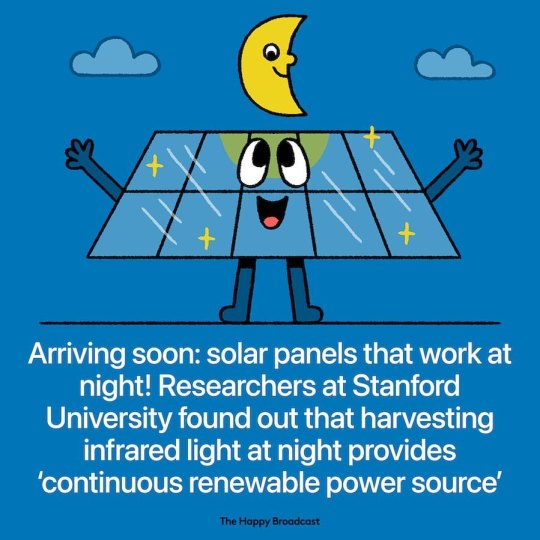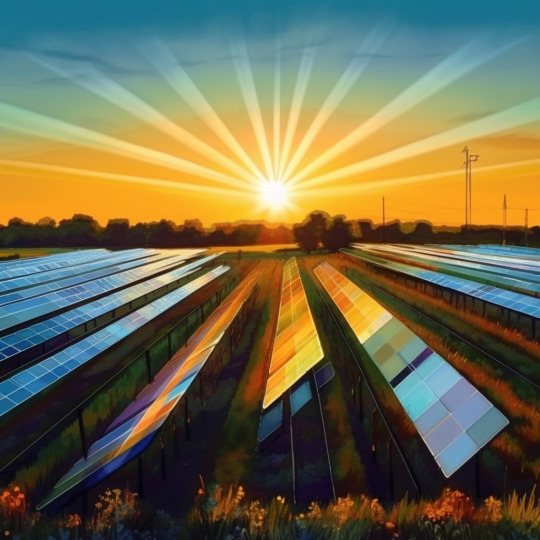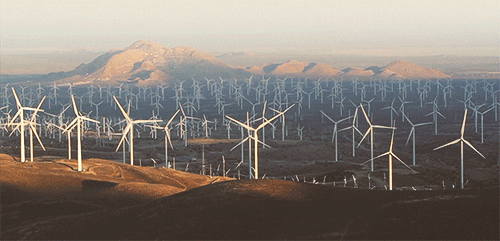#renewables
Text
"Solar accounted for most of the capacity the nation added to its electric grids last year. That feat marks the first time since World War II, when hydropower was booming, that a renewable power source has comprised more than half of the nation’s energy additions.
“It’s really monumental,” said Shawn Rumery, senior director of research at the Solar Energy Industries Association, or SEIA. The trade group announced the 2023 numbers in a report released today [March 6, 2024] with analytics firm Wood MacKenzie. The 32.4 gigawatts that came online in the United States last year shattered the previous high of 23.6 gigawatts recorded in 2021 and accounted for 53 percent of new capacity. Natural gas was next in line at a distant 18 percent.
SEIA called 2023 the best year for renewables since the Second World War. Texas and California led a solar surge driven mostly by utility-scale installations, which jumped 77 percent year-over-year to 22.5 gigawatts. The residential and commercial sectors also reached new milestones. Only the relatively nascent community solar market missed its previous mark, though not by much, said Rumery. Overall he called it an “almost record setting year across the industry.”
...Experts generally expect renewable energy to keep on its torrent trajectory.
“It’s very likely to continue because solar and wind are now very well established,” said Rob Stoner, director of the MIT Energy Initiative. “Solar costs continue to fall far below where we ever thought they would.”"
-via Grist, March 6, 2024
#clean energy#green energy#climate change#crisis#climate action#climate hope#renewables#solar power#united states#texas#california#good news#hope
975 notes
·
View notes
Text

1K notes
·
View notes
Photo

Nearly 50 countries now generate more than 50 per cent of their electricity from renewable energy sources
513 notes
·
View notes
Photo

Invisible Solar
Invisible Solar is a new PV technology that take on the appearance of any building material. Each Invisible Solar module is more than a photovoltaic panel, it also is an active architectural element with various functionality.
Disguising solar panels as ancient Roman tiles in Pompeii

"They look exactly like the terracotta tiles used by the Romans, but they produce the electricity that we need to light the frescoes," says Gabriel Zuchtriegel, Director of the Archaeological Park of Pompeii. This solution is part of a more comprehensive strategy to turn costs into savings opportunities and to embrace sustainable development.
Technically called "traditional PV tiles", the invisible solar panels used in Pompeii come from Camisano Vicentino, a little Italian town with slightly more than 10 000 inhabitants, halfway between Padua and Vicenza. They were created and patented by the family business Dyaqua.

How They Work

Operating of Invisible Solar modules is based on the low molecular density. Each module is composed of a non-toxic and recyclable polymeric compound we properly developed to encourage the photon absorption.
Inside the module there are incorporated standard monocrystalline silicon cells. The surface, that is opaque at the sight but translucent to sun rays, allows the light to enter and feed the cells.

Oh my goodness.
Solar voltaic’s designed for historic contexts that offers architectural and aesthetic integration?
AND they are already installed in Pompeii and not marketing vapourware?
AND they are made by a small Italian family business?
Be still my beating solarpunk heart 🥰 ☀️
via @stml in a forum.
#solarpunk#solar punk#solar power#voltaics#solar panels#terracotta#pompeii#renewables#solar energy#Aesthetic#Architecture
3K notes
·
View notes
Text

#meme#mattsmemes#memes that make you go hmmm#good point actually#environment#environmentalism#green earth#climate change#renewable energy#renewables
2K notes
·
View notes
Text
In France, all new and existing medium to large parking lots will have to be covered by solar panels

In France, solar just got a huge boost from new legislation approved through the Senate this week that requires all parking lots with spaces for at least 80 vehicles – both existing and new – be covered by solar panels.
Starting July 1, 2023, smaller carparks that have between 80 and 400 spaces will have five years to be in compliance with the new measures. Carparks with more than 400 spaces have a shorter timeline: They will need to comply with the new measures within three years of this date, and at least half of the surface area of the parking lot will need to be covered in solar panels.

Other measures on the table include building large solar farms on vacant land found alongside highways and railways, as well as on agricultural lands where feasible.
France’s national rail service SNCF also plans to install some 190,000 square meters of solar panels in 156 stations throughout the country by 2025 and 1.1 million square meters by 2030, all with the aim to reduce energy consumption by 25%.

The government also plans to build around 50 additional wind farms likes the one offshore Saint-Nazaire by 2050 in France. Measures are in place to reduce delays in building offshore wind farms from 10-12 years down to six years, and large solar farms from six years to three years.
(Source: Electrek, November 8th 2022)
2K notes
·
View notes
Text
The public wants to save the planet – as long as it doesn’t personally inconvenience them
“Back in July, Just Stop Oil (JSO) experienced something unusual – they found they were the ones being protested. An alternative group called Just Stop Pissing People Off attempted to block Just Stop Oil from engaging in disruptive protests and interrupted their events, saying that the climate crisis is real but that JSO is distracting and alienating people. The counter-protests tell us a great deal about Britain’s contradictory attitude to the climate crisis.
“Broadly, Brits understand that the climate crisis climate change is a major problem. 65% of us are worried about the climate crisis (versus just 28% who aren’t) while the same proportion supports the government’s aim of reducing Britain’s net carbon emissions to zero by 2050 ... Eight in 10 back more tree planting, subsidies for energy-efficient homes and higher taxes for high-carbon companies. 62% would support a requirement for all energy production to come from renewable sources. But this enthusiasm has its limits.
“When asked if they would back policies that would impose limits on what they personally can do, Brits quickly turn against them. For instance, two-thirds oppose the idea of a limit on how much meat they can buy, and a majority oppose banning petrol and diesel cars ... Even though 62% of voters back the idea of requiring all energy to be renewable, just 39% want to ban new North Sea oil fields, and a mere 32% want to prohibit the sale of gas boilers ...
“The British public is not as supportive of action on the climate crisis as many environmentalists would hope. We favour general, uncontentious ideas – net zero, tree-planting, tax rises on high-carbon companies – but when asked for our opinion on a climate policy that would directly affect us personally, we baulk. This is partly due to worries about the cost of living, but it’s also about avoiding personal inconvenience.
“Just Stop Pissing Everyone Off perfectly encapsulates the British attitude to the climate crisis: sure, it’s a problem, but not ours. As Homer Simpson once asked: ‘Can’t someone else do it?’”
#just stop oil#climate activists#climate activism#activism#climate crisis#climate breakdown#climate change#climate#tree planting#home insulation#low emission zones#renewable energy#renewables#oil and gas#fossil fuels#motorists#public opinion#brits#uk
281 notes
·
View notes
Text
Scientists in Britain announced Thursday they had smashed a record for generating fusion energy in the final experiment using the Joint European Torus (JET) machines.
Nuclear fusion is the same process that the sun uses to generate heat. Proponents believe it could one day help tackle climate change by providing an abundant, safe and clean source of energy.
Continue Reading.
83 notes
·
View notes
Photo

if I had to consume one of those birds I'd definitely pick the dodo: fat and sumptuous, easy to catch, not subject to global market price volatility
- Microplastics
1K notes
·
View notes
Photo

It likely goes without saying, but of all the energy solar panels generated last year, none of it was produced at night. New research is showing that doesn't have to be the case. Researchers at Stanford modified commercially available solar panels to generate a small amount of electricity at night by exploiting a process known as radiative cooling, which relies on, no lie, the frigid vacuum of space. When an object is facing the sky at night, it radiates heat out to outer space, which means that an object can become cooler than the air temperature around it. This effect could have obvious applications in cooling buildings, but the difference in temperature can also be used to generate electricity. While the modified panels generate a tiny amount of energy compared with what a modern solar panel does during the day, that energy could still be useful, especially at night when energy demand is much lower, the researchers said. Source: CNET (link in bio) #solarenergy #technology #renewables https://www.instagram.com/p/Cd-4fWmrfNc/?igshid=NGJjMDIxMWI=
2K notes
·
View notes
Photo



Envision Our Energizing-Vibrant Renewable Future Now
#earth day#earth month#renewable energy#renewable power#ai art#ai#image generation#design#climate art#renewable electricity#power sources#vibrant skies#solar power#solar#wind#wind energy#green future#solarpunk#renewables#midjourney#imagination#image building
248 notes
·
View notes
Text
"The last coal-fired power plant in New England, which had been the focus of a lawsuit and protests, is set to close in a victory for environmentalists.
Granite Shore Power said Wednesday it reached an agreement with the Environmental Protection Agency to close the Merrimack Station in New Hampshire by June 2028. As part of the deal, the company said the site will be turned into the state’s first renewable energy park that host solar power and battery storage systems. The company also said it would shutter Schiller Station in Portsmouth in December 2025. That facility, which is permitted to use oil, coal and biomass, has not operated for several years...
The 460-megawatt station in Bow has long been a thorn in the side of environmental groups. Most recently, the Sierra Club and the Conservation Law Foundation filed a lawsuit against plant owners, alleging it was violating the Clean Water Act. The plant was owned by Eversource until 2018, when it was sold to Connecticut-based Granite Shore Power. Both were named as defendants.
The environmental groups claimed the plant draws about 287 million gallons (1.1 billion liters) of water per day from the Merrimack River, heats that water as a result of its cooling process, and then discharges the water back into the river at temperatures that often exceed 90 degrees Fahrenheit (32 degrees Celsius).
Climate activists also protested the plant and demanded its closure over concerns it is a major source of air pollution. [Note: Coal plants are by definition major sources of air pollution. x] In one incident, climate activists last year paddled canoes and kayaks down the Merrimack River to the plant site and were arrested after going onto the property.
“This historic victory is a testament to the strength and resolve of those who never wavered in the fight for their communities and future,” Ben Jealous, Sierra Club Executive Director, said in a statement. “The people of New Hampshire and all of New England will soon breathe cleaner air and drink safer water.”
The Sierra Club said the announcement will make New Hampshire the 16th state that is coal-free and New England the second coal-free region in the country."
-via AP News, March 28, 2024
--
Note: It doesn't say it in this article, but the coal plants are being replaced by renewables! Specifically solar and battery farms! Source
#fossil fuels#air pollution#renewables#renewable energy#coal#pollution#mining#environment#solar power#battery#united states#new hampshire#good news#hope
541 notes
·
View notes
Text
#permaculture#city planning#solarpunk#renewableenergy#renewables#sustainability#green future#green infrastructure#green technology#functional supply chains
58 notes
·
View notes
Photo

Solar and wind poer potential of France.
by viola__alba
79 notes
·
View notes
Text
Ireland: Wind generation exceeds demand for electricity for the first time ever | Euronews
65 notes
·
View notes
Text
Let's talk Energy Mix

Let me talk about the energy mix for a moment - because I feel a lot of people are very unsure, how a renewable energy grid would work in practice.
So, let me get out my electrician gear and go very quickly through the different energy types that we would probably have within a Solarpunk world or something along the line. Or rather: What we might have in the future, if our governments actually fucking cared to go carbonfree.
Photovoltaic (aka Solar). Now, let me make one thing clear: Technically Photovoltaic and Solar are two different things. Photovoltaic uses certain materials that can build electricity when they interact with Photons, while Solar uses the sun's heat radiation. What most people think of as "Solarpower" is photovoltaic. This technology has made a lot of advances recently, making the panels so much more efficient than they were only a few years ago. By now photovoltaic roof tiles can actually provide enough energy for the house even during cloudy days and even further up north. Of course they cannot create enough energy during the night. While production is not 0, it is by far not enough.
Wind turbines. Currently wind turbines are making up a lot of the renewable energy mix in many countries, like my own (Germany). And for good reason. They are so darn efficient. Especially off-shore energy. While they are right now not useful for personal energy production (because turbines are fucking loud up close - only up close), they are really good at keeping the grid fed. Maybe just a bit too good.
Other forms of Wind Power. I really do not want to go too deeply into this topic. But there are currently also other forms of wind powered generators being researched. Including some that could be put onto houses. (If you want me to gover those more, just send me an ask.)
Hydro Power. Now Hydro Power, so water based power generation, has two big kinds of being used. One is by channeling the power of rivers through a generator - the other is as the currently simplest form of energy storage: If you have too much energy in your grid at any given time, pump water into a reservoir and if you need that power again, let it go through a generator. Please note though: Environmentally Hydro Power is definitely the kind of renewable power with the worst environmental impact.
Other forms of water based power generation: Currently we are experimenting a lot with getting power from the ocean. For example through tidal generators or wave generators. So far, though, these methods are only experiments, not fit for large scale production.
Geothermal Power. In a lot of areas with Geothermal activity we can also use the heat of the earth to create steam, which we then can use to power generators as well. This is especially handy in places like Iceland, that are geothermically very active, but also do not get a lot of sun half of the year and are not ideally suited for wind power.
One thing that should be noted is, that very probably we are still gonna need nuclear power as an emergency tool.
One thing that definitely needs to change, though, is how we build our energy grids. Currently we are relying a lot on macro grids, that is grids, where a few central power plants generate all the power for a large area. This does not work out well currently, based on the fact that a lot of renewables work best, if you have smaller, further distributed power plants.
This creates the need for micro grids, that are also better suited to just... Not create large scale blackouts, as the US experiences them semi-frequently.
Again, if you want me to talk more about that, I can totally do, just... send me a message.
But what you really do not need to be concerned about is the entire idea of "what do we do at night"? We have ways to deal with that. Even now. Let alone in 10 years. This area of science is currently really moving forward in long strides!

#solarpunk#lunarpunk#renewables#renewable energy#solar power#solar energy#photovoltaic#wind power#hydro power#energy mix
87 notes
·
View notes